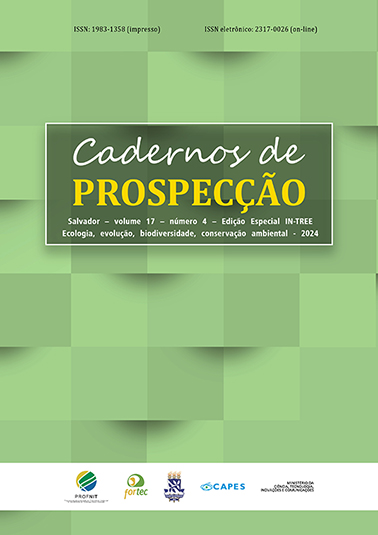Floating Solar Panels with Tracking Systems: an analysis from the perspective of Technology Readiness Levels
DOI:
https://doi.org/10.9771/cp.v17i4.61784Keywords:
Technology Readiness Levels, Floating Solar Panels with Tracking System, Renewable Energy.Abstract
This study explores the innovation and applicability of floating solar panels with tracking systems using the Technology Readiness Levels (TRLs) methodology, based on the ABNT NBR ISO 16290:2015 standard, to investigate the technological development of these systems. This method allows for a standardized and dynamic assessment of the development stage of the technologies under study. The overall objective of this work is to evaluate the current development stage of floating solar panels with tracking systems, using the Technology Readiness Levels (TRLs) methodology through a bibliometric approach and a patent survey. The TRL analysis provided insight into the technological advancement in solar energy and highlighted the potential and challenges of floating solar panels with tracking systems, emphasizing the need for research, development, and collaboration across sectors to drive innovation and application of these systems.
Downloads
References
CALAZANS, C. C. et al. Sementes Florestais e seu Potencial Tecnológico: uma análise de metadados. Cadernos de Prospecção, Salvador, v. 14, n. 3, p. 794 - 796, setembro, 2021. DOI: 10.9771/cp.v14i3.42765. Disponível em: https://periodicos.ufba.br/index.php/nit/article/view/42765. Acesso em: 8 abr. 2024.
CHEN, M. et al. Evaluation of solar energy transmission and heat-mass transfer in a floating solar concentrated distillation configuration. Sustainable Energy Technologies and Assessments. Elsevier, [s.l.], 2022.
HUANG, C.; PAN, H.; LIN, K. Development of Intelligent Fuzzy Controller for a Two-Axis Solar Tracking System. Applied Sciences-Basel, [s.l.], v. 6, Issue 5, 2016. DOI: 10.3390/app6050130.
IDOKO, J. A. et al. Design of Automatic Solar Tracking System Prototype to Maximize Solar Energy Extraction. In: IEEE PES/IAS POWERAFRICA, Nairóbi, Quênia, 2020, p. 1-5. Anais [...]. Nairóbi, Quênia, 2020. DOI: 10.1109/PowerAfrica49420.2020.9219860..
ITA – INSTITUTO TECNOLÓGICO DE AERONÁUTICA E ESPAÇO. Observatório Tecnológico (VDIR-CT-OT). Calculadoras TRL e MRL. 2021. Disponível em: https://iae.dcta.mil.br/index.php/calculadoras-trl-e-mrl. Acesso em: 1º abr. 2024.
KUMAR, K. N.; SUBRAMANIAM, V. Real Time Clock based Energy Efficient Automatic Dual Axis Solar Tracking System. Engineering Journal, [s.l.], v. 22, n. 1, p. 15-26, jan. 2018. DOI: 10.4186/ej.2018.22.1.15.
LASEINDE, T.; RAMÉRE, D. Low-cost automatic multi-axis solar tracking system for performance improvement in vertical support solar panels using Arduino board. International Journal of Low-carbon Technologies, [s.l.], v. 14, n. 1, p. 76-82, mar. 2019.
LOPES, M. P. C. et al. Technical potential of floating photovoltaic systems on artificial water bodies in Brazil. Renewable Energy, [s.l.], 2022.
MARTINS, Guilherme Santos; GIESBRECHT, Mateus. Hybrid approaches based on Singular Spectrum Analysis and k- Nearest Neighbors for clearness index forecasting. Renewable Energy, [s.l.], v. 219, Part 1, 2023. DOI: 10.1016/j.renene.2023.119434.
NORTE ENERGIA. Projeto da Norte Energia vai levar energia solar a aldeias do Médio Xingu. 2021. Disponível em: https://www.norteenergiasa.com.br/pt-br/imprensa/releases/projeto-da-norte-energia-vai-levar-energia-solar-a-aldeias-do-medio-xingu-100942. Acesso em: 1º out. 2022.
PATERNOSTRO, A. G.; QUINTELLA, C. M.; LEITE, H. J. D. Pesquisa Exploratória Comparativa entre Artigos e Patentes Sobre Maturidade (Prontidão) Tecnológica. Cadernos de Prospecção, Salvador, v. 13, n. 4, p. 1088 - 1089, setembro, 2020. DOI: 10.9771/cp.v13i4.33176. Disponível em: https://periodicos.ufba.br/index.php/nit/article/view/33176. Acesso em: 8 abr. 2024.
QUESTEL ORBIT INTELLIGENCE. Base de dados: Internet. 2024. Disponível em: https://www.orbit.com. Acesso em: 3 jan. 2024.
RIBEIRO, M. E.; FREY, I. A.; AZEVEDO, P. Classificação das Patentes em Universidades Federais na Escala TRL (Technology Readiness Level): estudo de caso a partir da Norma ISO 16290:2013. Cadernos de Prospecção, Salvador, v. 15, n. 1, p. 117-130, janeiro a março, 2022. DOI: 10.9771/cp.v15i1.42173. Disponível em: https://periodicos.ufba.br/index.php/nit/article/view/42173. Acesso em: 8 abr. 2024.
ROCHA, D.; RIBEIRO, J. R.; SALGADO, M. C. V. Proposta de Padronização do Cálculo da Maturidade Tecnológica. In: ANDRADE, H. de S.; CHAGAS JUNIOR, M. de F.; SILVA, M. B. (org.). Avaliação da Maturidade Tecnológica: conceitos e aplicações. Jundiaí: Edições Brasil/Editora Fibra, 2019. p. 189 - 210.
SILVA, A. P.; DUTRA, F. G. de C.; FIGUEIREDO, D. B. S. Aplicação da Inteligência Artificial na Segurança do Trabalho para a Prevenção de Acidentes: um estudo bibliométrico. Cadernos de Prospecção, Salvador, v. 16, n. 6, p. 1.956-1.970, outubro a dezembro, 2023. DOI: 10.9771/cp.v16i6.54587. Disponível em: https://periodicos.ufba.br/index.php/nit/article/view/54587. Acesso em: 8 abr. 2024.
SOUZA, Carlos Roberto Pinto de et al. Prospecção Tecnológica Aplicada a Tecnologias de Coleta de Energia Solar. Cadernos de Prospecção, Salvador, v. 11, n. 4, p. 1.085-1.098, dez. 2018.
TCHAO, E. T. An Implementation of an Optimized Dual-Axis Solar Tracking Algorithm for Concentrating Solar Power Plants Deployment. Scientific African, [s.l.], v. 16, art. e01228, 2022. DOI: 10.1016/j.sciaf.2022.e01228.
Downloads
Published
How to Cite
Issue
Section
License
Copyright (c) 2024 Cadernos de Prospecção

This work is licensed under a Creative Commons Attribution-NonCommercial 4.0 International License.
O autor declara que: - Todos os autores foram nomeados. - Está submetendo o manuscrito com o consentimento dos outros autores. - Caso o trabalho submetido tiver sido contratado por algum empregador, tem o consentimento do referido empregador. - Os autores estão cientes de que é condição de publicação que os manuscritos submetidos a esta revista não tenham sido publicados anteriormente e não sejam submetidos ou publicados simultaneamente em outro periódico sem prévia autorização do Conselho Editorial. - Os autores concordam que o seu artigo ou parte dele possa ser distribuído e/ou reproduzido por qualquer forma, incluindo traduções, desde que sejam citados de modo completo esta revista e os autores do manuscrito. - Revista Cadernos de Prospecção está licenciado com uma Licença Creative Commons Attribution 4.0. Esta licença permite que outros remixem, adaptem e criem a partir do seu trabalho para fins não comerciais, e embora os novos trabalhos tenham de lhe atribuir o devido crédito e não possam ser usados para fins comerciais, os usuários não têm de licenciar esses trabalhos derivados sob os mesmos termos.
Este obra está licenciado com uma Licença Creative Commons Atribuição 4.0 Internacional.








